cooling ASTON MARTIN V8 VANTAGE 2010 Owner's Manual
[x] Cancel search | Manufacturer: ASTON MARTIN, Model Year: 2010, Model line: V8 VANTAGE, Model: ASTON MARTIN V8 VANTAGE 2010Pages: 947, PDF Size: 43.21 MB
Page 362 of 947
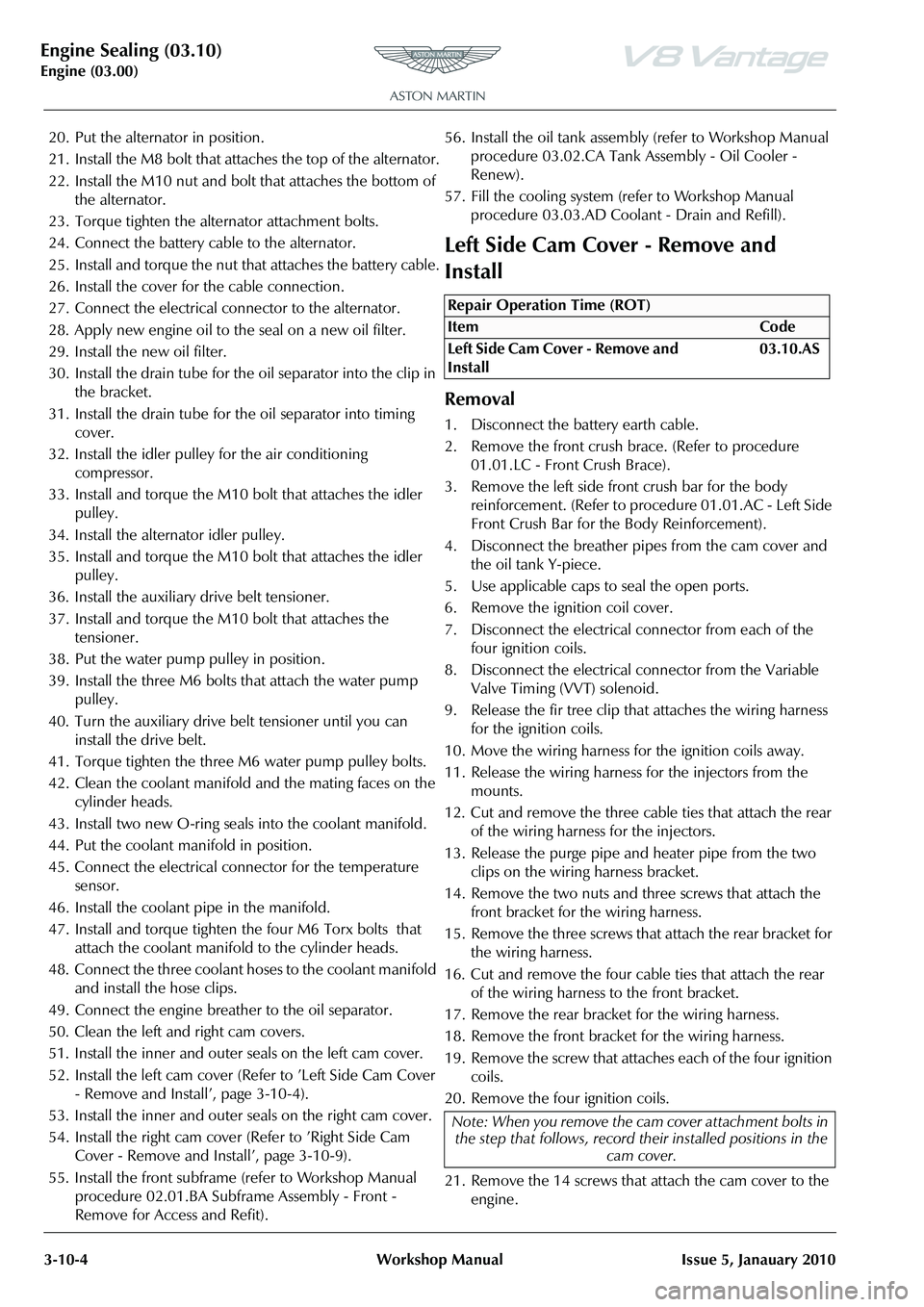
Engine Sealing (03.10)
Engine (03.00)3-10-4 Workshop Manual Issue 5, Janauary 2010
20. Put the alternator in position.
21. Install the M8 bolt that attaches the top of the alternator.
22. Install the M10 nut and bolt that attaches the bottom of the alternator.
23. Torque tighten the alternator attachment bolts.
24. Connect the battery cable to the alternator.
25. Install and torque the nut that attaches the battery cable.
26. Install the cover for the cable connection.
27. Connect the electrical connector to the alternator.
28. Apply new engine oil to the seal on a new oil filter.
29. Install the new oil filter.
30. Install the drain tube for the oil separator into the clip in the bracket.
31. Install the drain tube for the oil separator into timing cover.
32. Install the idler pulley for the air conditioning compressor.
33. Install and torque the M10 bolt that attaches the idler pulley.
34. Install the alternator idler pulley.
35. Install and torque the M10 bolt that attaches the idler pulley.
36. Install the auxiliary drive belt tensioner.
37. Install and torque the M10 bolt that attaches the tensioner.
38. Put the water pump pulley in position.
39. Install the three M6 bolts that attach the water pump pulley.
40. Turn the auxiliary drive be lt tensioner until you can
install the drive belt.
41. Torque tighten the three M6 water pump pulley bolts.
42. Clean the coolant manifold and the mating faces on the cylinder heads.
43. Install two new O-ring seals into the coolant manifold.
44. Put the coolant manifold in position.
45. Connect the electrical connector for the temperature sensor.
46. Install the coolant pipe in the manifold.
47. Install and torque tighten the four M6 Torx bolts that attach the coolant manifold to the cylinder heads.
48. Connect the three coolant hoses to the coolant manifold and install the hose clips.
49. Connect the engine breather to the oil separator.
50. Clean the left and right cam covers.
51. Install the inner and outer seals on the left cam cover.
52. Install the left cam cover (Refer to ’Left Side Cam Cover - Remove and Install’, page 3-10-4).
53. Install the inner and outer seals on the right cam cover.
54. Install the right cam cover (Refer to ’Right Side Cam Cover - Remove and Install’, page 3-10-9).
55. Install the front subframe (refer to Workshop Manual procedure 02.01.BA Subframe Assembly - Front -
Remove for Access and Refit). 56. Install the oil tank assembly
(refer to Workshop Manual
procedure 03.02.CA Tank Assembly - Oil Cooler -
Renew).
57. Fill the cooling system (refer to Workshop Manual procedure 03.03.AD Coolant - Drain and Refill).
Left Side Cam Cover - Remove and
Install
Removal
1. Disconnect the battery earth cable.
2. Remove the front crush brace. (Refer to procedure 01.01.LC - Front Crush Brace).
3. Remove the left side front crush bar for the body reinforcement. (Refer to procedure 01.01.AC - Left Side
Front Crush Bar for the Body Reinforcement).
4. Disconnect the breather pi pes from the cam cover and
the oil tank Y-piece.
5. Use applicable caps to seal the open ports.
6. Remove the ignition coil cover.
7. Disconnect the electrical connector from each of the four ignition coils.
8. Disconnect the electrical connector from the Variable
Valve Timing (VVT) solenoid.
9. Release the fir tree clip that attaches the wiring harness for the ignition coils.
10. Move the wiring harness for the ignition coils away.
11. Release the wiring harness for the injectors from the mounts.
12. Cut and remove the three cable ties that attach the rear of the wiring harness for the injectors.
13. Release the purge pipe an d heater pipe from the two
clips on the wiring harness bracket.
14. Remove the two nuts and three screws that attach the front bracket for the wiring harness.
15. Remove the three screws that attach the rear bracket for the wiring harness.
16. Cut and remove the four cable ties that attach the rear
of the wiring harness to the front bracket.
17. Remove the rear bracket for the wiring harness.
18. Remove the front bracket for the wiring harness.
19. Remove the screw that attaches each of the four ignition coils.
20. Remove the four ignition coils.
21. Remove the 14 screws that attach the cam cover to the
engine.
Repair Operation Time (ROT)
ItemCode
Left Side Cam Cover - Remove and
Install 03.10.AS
Note: When you remo ve the cam cover attachment bolts in
the step that follows , record their installed positions in the
cam cover.
Page 408 of 947
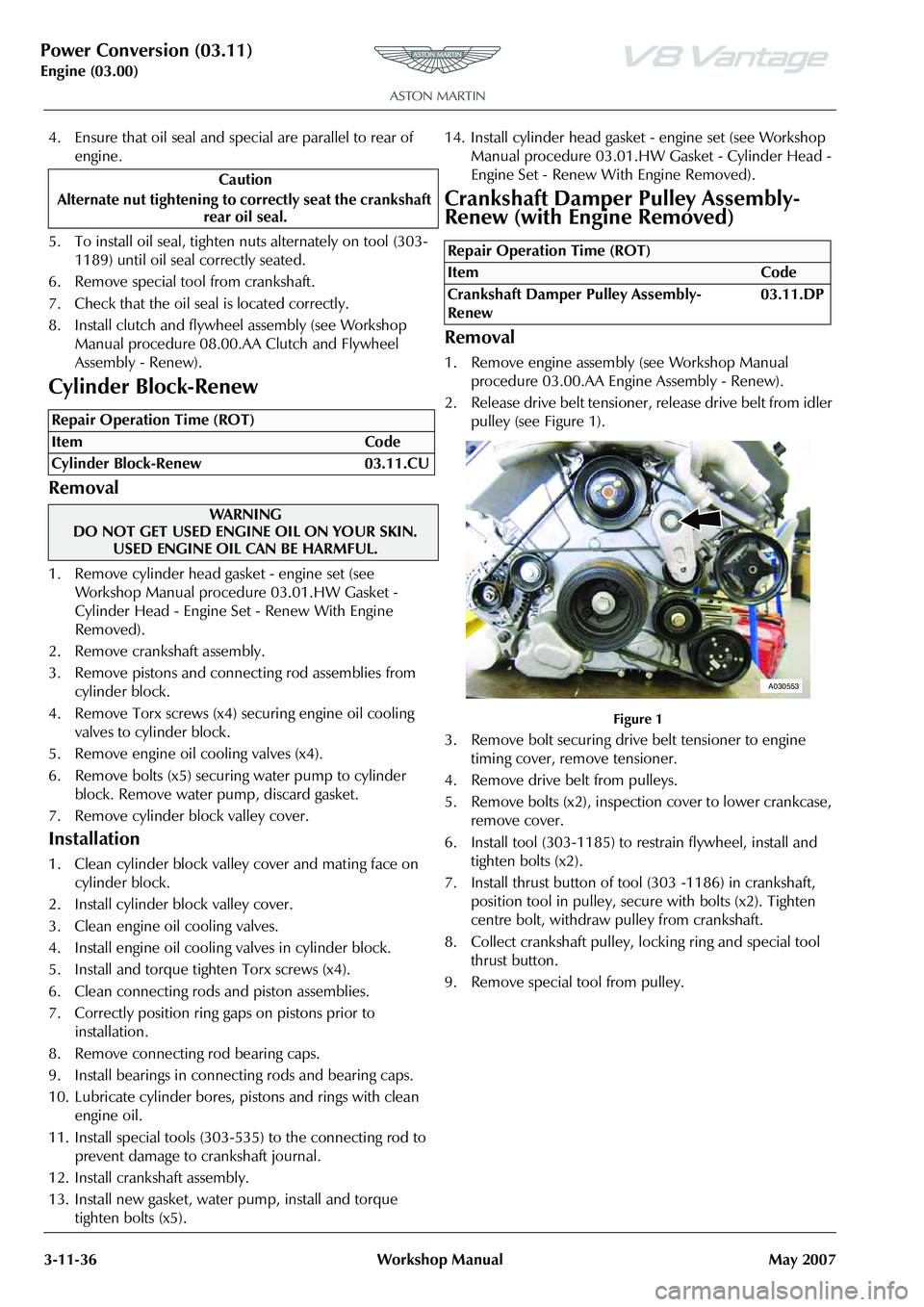
Power Conversion (03.11)
Engine (03.00)3-11-36 Workshop Manual May 2007
4. Ensure that oil seal and special are parallel to rear of
engine.
5. To install oil seal, tighten nuts alternately on tool (303- 1189) until oil seal correctly seated.
6. Remove special tool from crankshaft.
7. Check that the oil seal is located correctly.
8. Install clutch and flywheel assembly (see Workshop Manual procedure 08.00.AA Clutch and Flywheel
Assembly - Renew).
Cylinder Block-Renew
Removal
1. Remove cylinder head gasket - engine set (see Workshop Manual procedure 03.01.HW Gasket -
Cylinder Head - Engine Set - Renew With Engine
Removed).
2. Remove crankshaft assembly.
3. Remove pistons and connecting rod assemblies from cylinder block.
4. Remove Torx screws (x4) securing engine oil cooling
valves to cylinder block.
5. Remove engine oil cooling valves (x4).
6. Remove bolts (x5) securing water pump to cylinder block. Remove water pump, discard gasket.
7. Remove cylinder block valley cover.
Installation
1. Clean cylinder block valley cover and mating face on cylinder block.
2. Install cylinder block valley cover.
3. Clean engine oil cooling valves.
4. Install engine oil cooling valves in cylinder block.
5. Install and torque tighten Torx screws (x4).
6. Clean connecting rods and piston assemblies.
7. Correctly position ring gaps on pistons prior to installation.
8. Remove connecting rod bearing caps.
9. Install bearings in connecting rods and bearing caps.
10. Lubricate cylinder bores, pistons and rings with clean engine oil.
11. Install special tools (303-535) to the connecting rod to prevent damage to crankshaft journal.
12. Install crankshaft assembly.
13. Install new gasket, water pump, install and torque tighten bolts (x5). 14. Install cylinder head gasket - engine set (see Workshop
Manual procedure 03.01.HW Gasket - Cylinder Head -
Engine Set - Renew Wi th Engine Removed).
Crankshaft Damper Pulley Assembly-
Renew (with Engine Removed)
Removal
1. Remove engine assembly (see Workshop Manual
procedure 03.00.AA Engine Assembly - Renew).
2. Release drive belt tensioner, release drive belt from idler pulley (see Figure 1).
Figure 1
3. Remove bolt securing drive belt tensioner to engine timing cover, remove tensioner.
4. Remove drive belt from pulleys.
5. Remove bolts (x2), inspection cover to lower crankcase, remove cover.
6. Install tool (303-1185) to restrain flywheel, install and tighten bolts (x2).
7. Install thrust button of tool (303 -1186) in crankshaft,
position tool in pulley, secure with bolts (x2). Tighten
centre bolt, withdraw pulley from crankshaft.
8. Collect crankshaft pulley, locking ring and special tool thrust button.
9. Remove special tool from pulley.
Caution
Alternate nut tightening to correctly seat the crankshaft rear oil seal.
Repair Operation Time (ROT)
WAR NI NG
DO NOT GET USED ENGINE OIL ON YOUR SKIN.
USED ENGINE OIL CAN BE HARMFUL.
Repair Operation Time (ROT)
ItemCode
Crankshaft Damper Pulley Assembly-
Renew 03.11.DP
A030553
Page 453 of 947
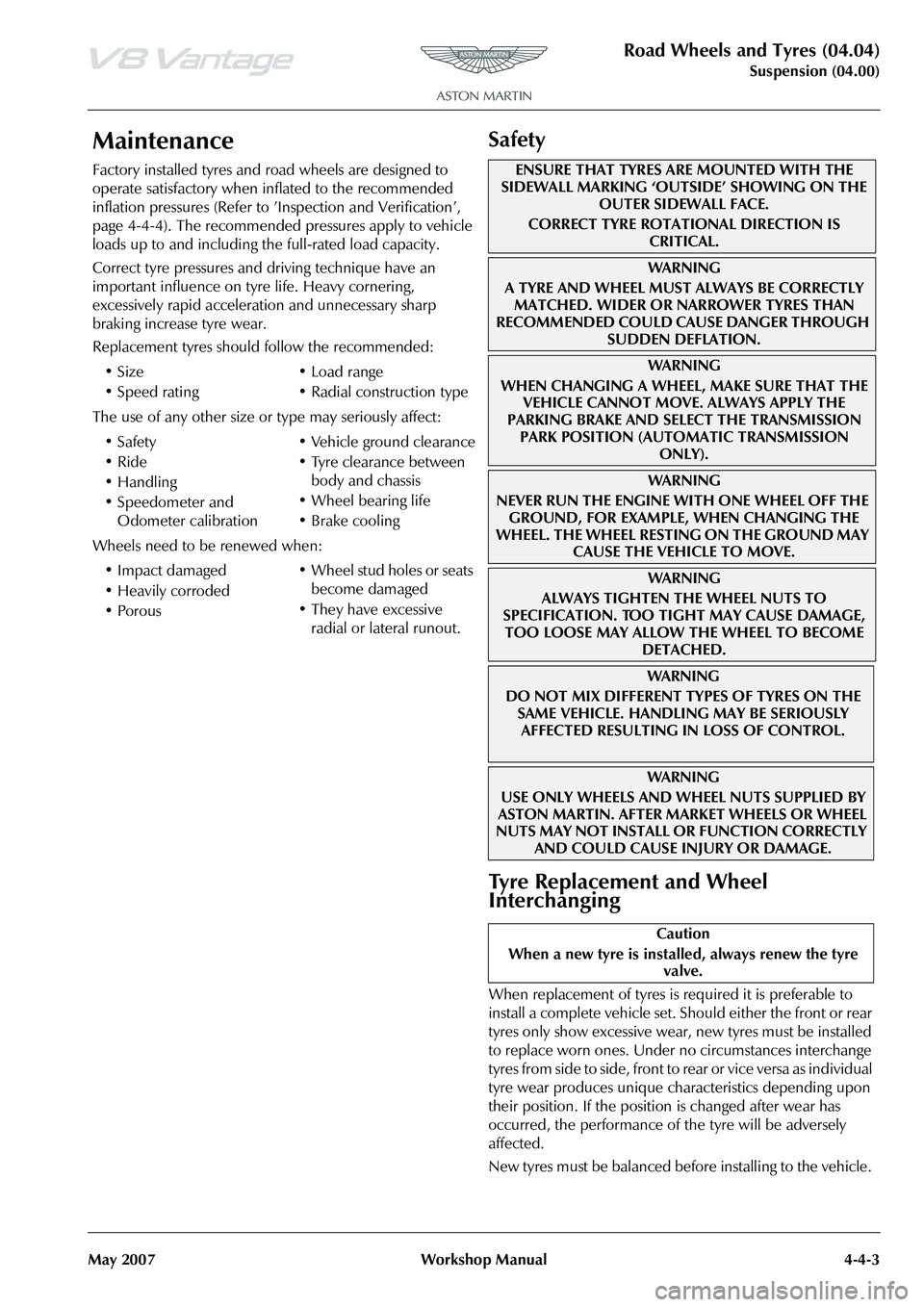
Road Wheels and Tyres (04.04)
Suspension (04.00)
May 2007 Workshop Manual 4-4-3
Maintenance
Factory installed tyres and road wheels are designed to
operate satisfactory when inflated to the recommended
inflation pressures (Refer to ’Inspection and Verification’,
page 4-4-4). The recommended pressures apply to vehicle
loads up to and including the full-rated load capacity.
Correct tyre pressures and driving technique have an
important influence on tyre life. Heavy cornering,
excessively rapid acceleration and unnecessary sharp
braking increase tyre wear.
Replacement tyres should follow the recommended:
The use of any other size or type may seriously affect:
Wheels need to be renewed when:
Safety
Tyre Replacement and Wheel
Interchanging
When replacement of tyres is required it is preferable to
install a complete vehicle set. S hould either the front or rear
tyres only show excessive wear, new tyres must be installed
to replace worn ones. Under no circumstances interchange
tyres from side to side, front to re ar or vice versa as individual
tyre wear produces unique characteristics depending upon
their position. If the position is changed after wear has
occurred, the performance of the tyre will be adversely
affected.
New tyres must be balanced before installing to the vehicle.
•Size
•Speed rating
•Load range
• Radial construction type
•Safety
•Ride
•Handling
• Speedometer and Odometer calibration • Vehicle ground clearance
• Tyre clearance between
body and chassis
• Wheel bearing life
• Brake cooling
• Impact damaged
• Heavily corroded
• Porous • Wheel stud holes or seats
become damaged
• They have excessive radial or lateral runout.
ENSURE THAT TYRES ARE MOUNTED WITH THE
SIDEWALL MARKING ‘OUTSIDE’ SHOWING ON THE
OUTER SIDEWALL FACE.
CORRECT TYRE ROTATIONAL DIRECTION IS CRITICAL.
WA R N I N G
A TYRE AND WHEEL MUST ALWAYS BE CORRECTLY MATCHED. WIDER OR NARROWER TYRES THAN
RECOMMENDED COULD CAUSE DANGER THROUGH
SUDDEN DEFLATION.
WA R N I N G
WHEN CHANGING A WHEEL, MAKE SURE THAT THE VEHICLE CANNOT MOVE. ALWAYS APPLY THE
PARKING BRAKE AND SELE CT THE TRANSMISSION
PARK POSITION (AUTOMATIC TRANSMISSION ONLY).
WA R N I N G
NEVER RUN THE ENGINE WITH ONE WHEEL OFF THE GROUND, FOR EXAMPLE, WHEN CHANGING THE
WHEEL. THE WHEEL RESTING ON THE GROUND MAY CAUSE THE VEHICLE TO MOVE.
WA R N I N G
ALWAYS TIGHTEN THE WHEEL NUTS TO
SPECIFICATION. TOO TIGHT MAY CAUSE DAMAGE,
TOO LOOSE MAY ALLOW TH E WHEEL TO BECOME
DETACHED.
WAR NI NG
DO NOT MIX DIFFERENT TY PES OF TYRES ON THE
SAME VEHICLE. HANDLING MAY BE SERIOUSLY AFFECTED RESULTING IN LOSS OF CONTROL.
WAR NI NG
USE ONLY WHEELS AND WHEEL NUTS SUPPLIED BY
ASTON MARTIN. AFTER MARKET WHEELS OR WHEEL
NUTS MAY NOT INSTALL OR FUNCTION CORRECTLY
AND COULD CAUSE INJURY OR DAMAGE.
Caution
When a new tyre is installe d, always renew the tyre
valve.
Page 513 of 947
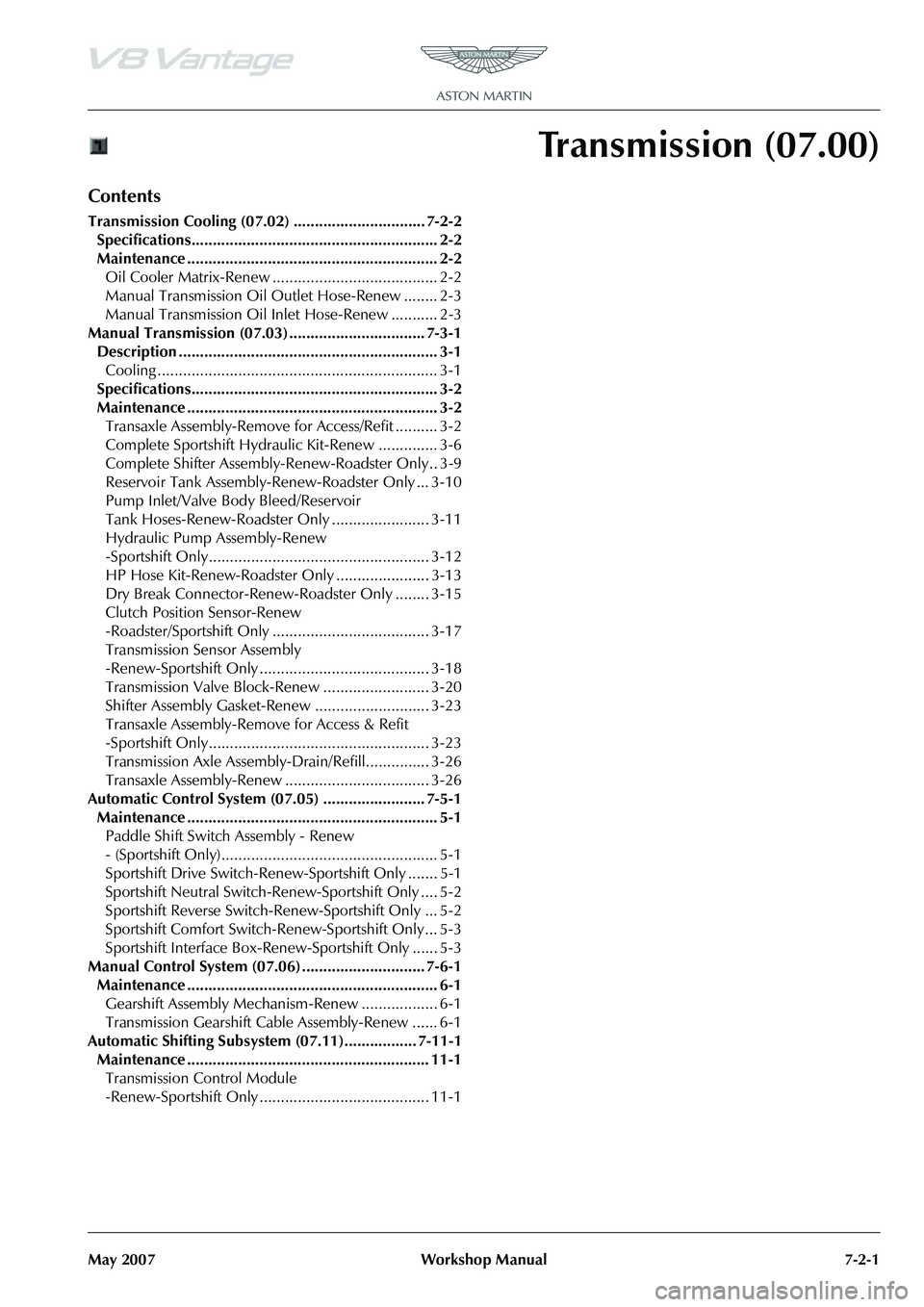
May 2007 Workshop Manual 7-2-1
Transmission (07.00)
Contents
Transmission Cooling (07.02) ............................... 7-2-2Specifications.......................................................... 2-2
Maintenance ........................................................... 2-2Oil Cooler Matrix-Renew ....................................... 2-2
Manual Transmission Oil Ou tlet Hose-Renew ........ 2-3
Manual Transmission Oil Inlet Hose-Renew ........... 2-3
Manual Transmission (07.03) ................................ 7-3-1 Description ............................................................. 3-1Cooling .................................................................. 3-1
Specifications.......................................................... 3-2
Maintenance ........................................................... 3-2 Transaxle Assembly-Remove for Access/Refit .......... 3-2
Complete Sportshift Hydraulic Kit-Renew .............. 3-6
Complete Shifter Assembly-Renew-Roadster Only.. 3-9
Reservoir Tank Assembly-Renew-Roadster Only ... 3-10
Pump Inlet/Valve Body Bleed/Reservoir
Tank Hoses-Renew-Roadster Only ....................... 3-11
Hydraulic Pump Assembly-Renew
-Sportshift Only.................................................... 3-12
HP Hose Kit-Renew-Roadster Only ...................... 3-13
Dry Break Connector-Renew-Roadster Only ........ 3-15
Clutch Position Sensor-Renew
-Roadster/Sportshift Only ..................................... 3-17
Transmission Sensor Assembly
-Renew-Sportshift Only ........................................ 3-18
Transmission Valve Block-Renew ......................... 3-20
Shifter Assembly Gasket-Renew ........................... 3-23
Transaxle Assembly-Remove for Access & Refit
-Sportshift Only.................................................... 3-23
Transmission Axle Assembly-D rain/Refill............... 3-26
Transaxle Assembly-Renew .................................. 3-26
Automatic Control System (07.05) ........................ 7-5-1 Maintenance ........................................................... 5-1Paddle Shift Switch Assembly - Renew
- (Sportshift Only)................................................... 5-1
Sportshift Drive Switch-Ren ew-Sportshift Only ....... 5-1
Sportshift Neutral Switch-Renew-Sportshift Only .... 5-2
Sportshift Reverse Switch-Renew-Sportshift Only ... 5-2
Sportshift Comfort Switch-Renew-Sportshift Only ... 5-3
Sportshift Interface Box-Re new-Sportshift Only ...... 5-3
Manual Control System (07.06) ............................. 7-6-1 Maintenance ........................................................... 6-1Gearshift Assembly Mechan ism-Renew .................. 6-1
Transmission Gearshift Cable Assembly-Renew ...... 6-1
Automatic Shifting Subsystem (07.11)................. 7-11-1 Maintenance ......................................................... 11-1Transmission Control Module
-Renew-Sportshift Only ........................................ 11-1
Page 514 of 947

Transmission Cooling (07.02)
Transmission (07.00)7-2-2 Workshop Manual May 2007
Transmission (07.00)
Transmission Cooling (07.02)
Specifications
Maintenance
Oil Cooler Matrix-Renew
Removal
1. Raise vehicle on ramp.
2. Remove rear exhaust silencer heatshield (see Workshop
Manual procedure 02.06.AG Heatshield - Exhaust
Muffler - Renew).
3. Position drain container to collect oil spillage. 4. Loosen oil cooler pipe unions (x2) (see Figure 1).
5. Remove nuts (x4) from oil cooler to rear bumper
armature.
07-02-001
Transmission Oil Cooler
Inlet Tube
Outlet Tube
Pipe Unions
Torque Figures
DescriptionNm.lb. / ft.
Cooler to subframe 8-10 6-7.5
Repair Operation Time (ROT)
Figure 1
WAR NI NG
OBSERVE ALL TRANSAXLE OIL MANUFACTURERS SAFETY INSTRUCTIONS WHEN HANDLING
COMPONENTS THAT HAVE BEEN IN CONTACT WITH
TRANSAXLE OIL.
07-02-002
Page 515 of 947

Transmission Cooling (07.02)
Transmission (07.00)
May 2007 Workshop Manual 7-2-3
6. Disconnect oil cooler pipes and remove oil cooler (see
Figure 2).
7. Install plugs in oil cooler and pipe connections.
Installation
1. Clean oil cooler, connections and mating face on subframe.
2. Remove plugs, position oil cooler and connect oil cooler pipes (do not tighten at this stage).
3. Install oil cooler and tighten nuts (x4).
4. Tighten pipe unions.
5. Top-up transaxle oil level.
6. Remove drain container.
7. Install rear exhaust silencer heatshield (see Workshop
Manual procedure 02.06.AG Heatshield - Exhaust
Silencer - Renew).
8. Lower vehicle on ramp.
Manual Transmission Oil Outlet Hose-
Renew
Removal
1. Raise vehicle on ramp.
2. Remove rear exhaust silencer heatshield (see Workshop Manual procedure 02.06.AG Heatshield - Exhaust
Muffler - Renew).
3. Release transaxle breather hose from oil cooler pipe.
4. Remove bolt, nuts (x2),insulating washers (x2) and plain washer securing outlet hose brackets to body.
5. Position container to collect oil spillage.
6. Loosen union and remove hose from oil cooler.
7. Loosen union and remove oil cooler hose from transaxle and collect hose.
1. Plug oil cooler and transaxle pipe connections.
Install
1. Clean hose connections and remove plugs.
2. Position hose, align brackets, install insulating washers (x2) and plain washer.
3. Install and tighten bolt and nuts (x2) to correct torque.
4. Connect and tighten hose unions to correct torque.
5. Remove drain container.
6. Install transaxle breather hose clip to oil cooler pipe.
7. Install rear exhaust silencer heatshield (see Workshop Manual procedure 02.06.AG Heatshield - Exhaust
Muffler - Renew).
8. Lower vehicle on ramp.
Manual Transmission Oil Inlet Hose-
Renew
Caution
Plug oil cooler connections to prevent ingress of dirt or moisture into the system.
Figure 2
WA R N I N G
OBSERVE ALL TRANSAXLE OIL MANUFACTURERS SAFETY INSTRUCTIONS WHEN HANDLING
COMPONENTS THAT HAVE BEEN IN CONTACT WITH TRANSAXLE OIL.
WA R N I N G
OBSERVE ALL TRANSAXLE OIL MANUFACTURERS SAFETY INSTRUCTIONS WHEN HANDLING
COMPONENTS THAT HAVE BEEN IN CONTACT WITH
TRANSAXLE OIL.
Repair Operation Time (ROT)
07-02-003
WA R N I N G
TO AVOID PERSONAL INJURY, I.E. SEVERE BURNS TO THE SKIN, ALLOW EXHAUST SYSTEM TO COOL
DOWN BEFORE REMOVING EXHAUST SYSTEM COMPONENTS.
WA R N I N G
OBSERVE ALL TRANSAXLE OIL MANUFACTURERS SAFETY INSTRUCTIONS WHEN HANDLING
COMPONENTS THAT HAVE BEEN IN CONTACT WITH
TRANSAXLE OIL.
Caution
Plug oil cooler connections to prevent ingress of dirt or moisture into the system.
WA R N I N G
OBSERVE ALL TRANSAXLE OIL MANUFACTURERS SAFETY INSTRUCTIONS WHEN HANDLING
COMPONENTS THAT HAVE BEEN IN CONTACT WITH
TRANSAXLE OIL.
Repair Operation Time (ROT)
Page 516 of 947

Transmission Cooling (07.02)
Transmission (07.00)7-2-4 Workshop Manual May 2007
Removal
1. Raise vehicle on ramp.
2. Remove rear exhaust silencer heatshield (see Workshop
Manual procedure 02.06.AG Heatshield - Exhaust
Muffler - Renew).
3. Release transaxle breather hose from oil cooler pipe.
4. Remove bolt and nuts (x 2) that secure inlet hose
brackets to body.
5. Collect pipe insulating washers (x2) and plain washer.
6. Position container to collect oil spillage.
7. Loosen union and remove hose from oil cooler.
8. Loosen union and remove oil cooler hose from transaxle and collect hose.
1. Plug oil cooler and tr ansaxle pipe connections.
Install
1. Clean hose connections and remove plugs.
2. Position hose, align brackets, install insulating washers
and plain washer.
3. Install and tighten bolt and nuts (x2) to correct torque.
4. Connect and tighten hose unions to correct torque.
5. Remove drain container.
6. Install transaxle breather hose clip to oil cooler pipe.
7. Install rear exhaust silencer heatshield (see Workshop
Manual procedure 02.06.AG Heatshield - Exhaust
Muffler - Renew)
8. Lower vehicle on ramp. WAR NI NG
TO AVOID PERSONAL INJURY, I.E. SEVERE BURNS TO THE SKIN, ALLOW EXHAUS T SYSTEM TO COOL
DOWN BEFORE REMOVING EXHAUST SYSTEM COMPONENTS.
WAR NI NG
OBSERVE ALL TRANSAXLE OIL MANUFACTURERS
SAFETY INSTRUCTIONS WHEN HANDLING
COMPONENTS THAT HAVE BEEN IN CONTACT WITH TRANSAXLE OIL.
Caution
Plug oil cooler connections to prevent ingress of dirt or moisture into the system.
WAR NI NG
OBSERVE ALL TRANSAXLE OIL MANUFACTURERS SAFETY INSTRUCTIONS WHEN HANDLING
COMPONENTS THAT HAVE BEEN IN CONTACT WITH TRANSAXLE OIL.
Page 517 of 947

Manual Transmission (07.03)
Transmission (07.00)
Issue 5, January 2010 Workshop Manual 7-3-1
Transmission (07.00)
Manual Transmission (07.03)
Description
The Graziano rear transaxle installed to this vehicle
incorporates a six speed transm ission plus reverse, with
synchromesh on all gears. Gear selection is via an Integrated
Shifter Bellcrack System (Cable Operated).
Cooling
The manual transaxle has an external cooling circuit which
operates continuously by a fixed displacement pump driven
by the input shaft.
The cooler is mounted at the rear attached to the subframe.
Page 601 of 947
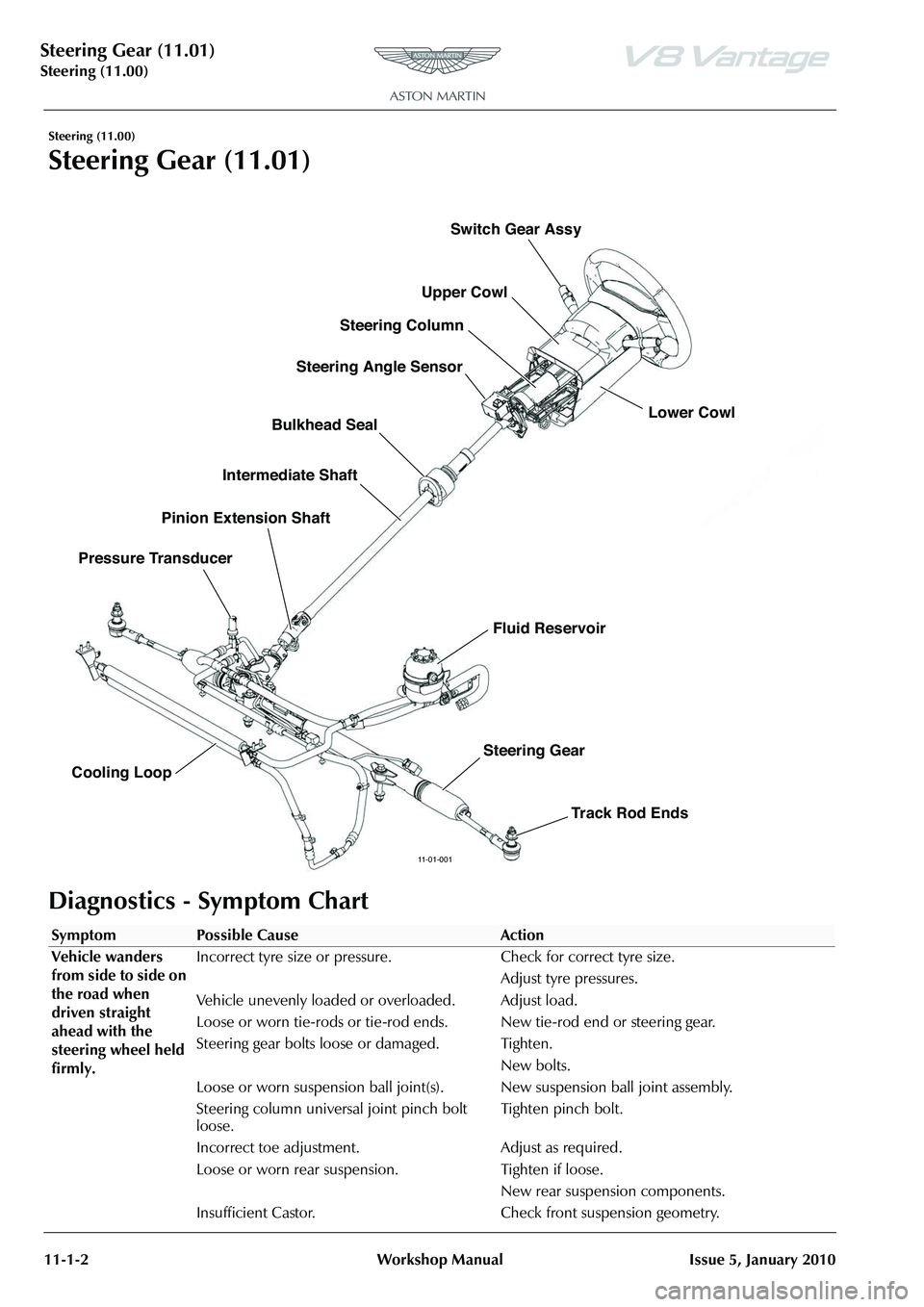
Steering Gear (11.01)
Steering (11.00)11-1-2 Workshop Manual Issue 5, January 2010
Steering (11.00)
Steering Gear (11.01)
Diagnostics - Symptom Chart
11-01-001
Upper Cowl Lower Cowl
Steering Column
Steering Angle Sensor
Bulkhead Seal
Intermediate Shaft
Pressure Transducer Pinion Extension Shaft
Cooling Loop Switch Gear Assy
Fluid Reservoir
Steering Gear Track Rod Ends
SymptomPossible CauseAction
Vehicle wanders
from side to side on
the road when
driven straight
ahead with the
steering wheel held
firmly. Incorrect tyre size or pressure. Check for correct tyre size.
Adjust tyre pressures.
Vehicle unevenly loaded or overloaded. Adjust load.
Loose or worn tie-rods or tie-rod ends. New tie-rod end or steering gear.
Steering gear bolts loose or damaged. Tighten. New bolts.
Loose or worn suspension ball joint(s). New suspension ball joint assembly.
Steering column universal joint pinch bolt
loose. Tighten pinch bolt.
Incorrect toe adjustment. Adjust as required.
Loose or worn rear suspension. Tighten if loose. New rear suspension components.
Insufficient Castor. Check fr ont suspension geometry.
Page 604 of 947
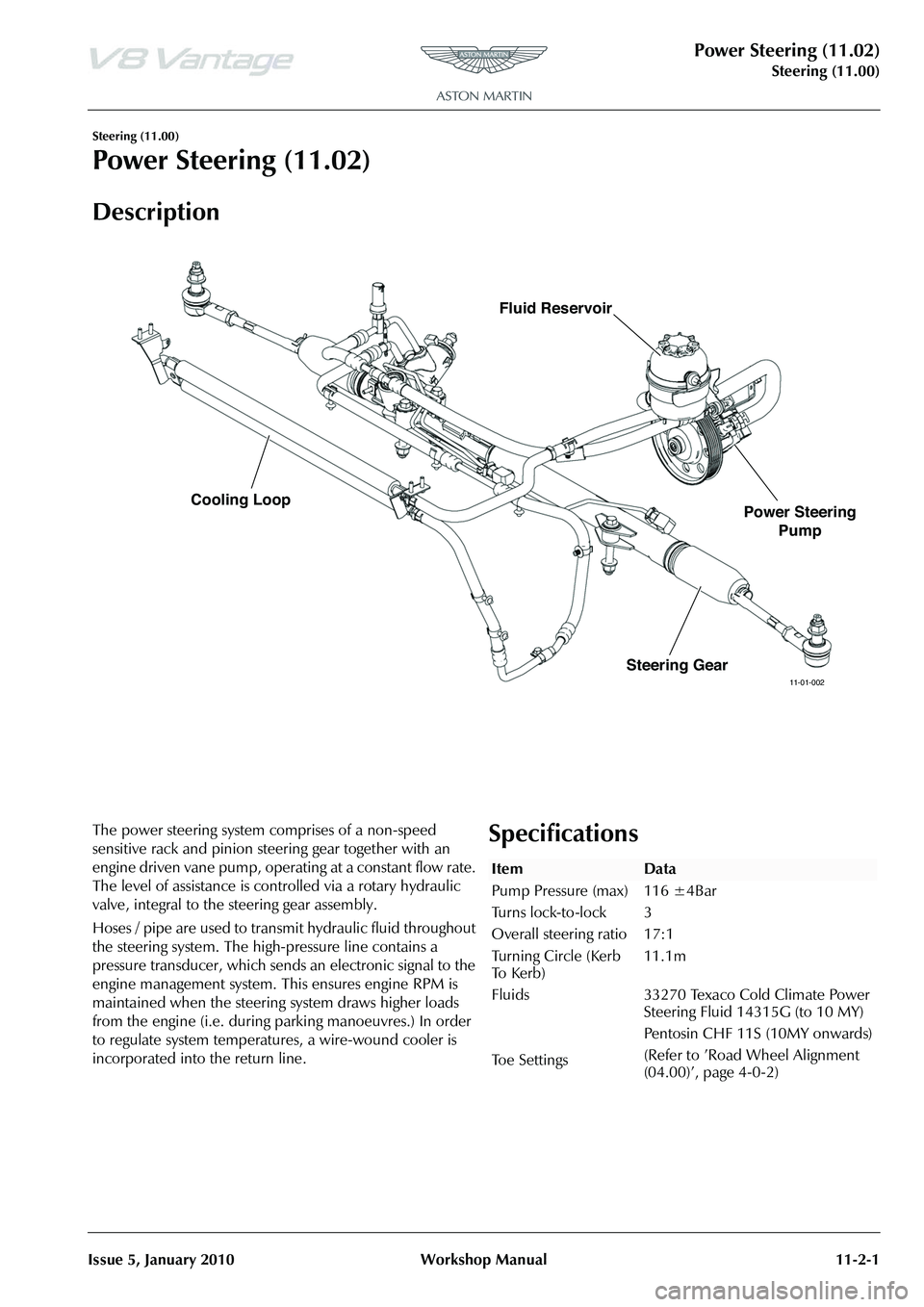
Power Steering (11.02)
Steering (11.00)
Issue 5, January 2010 Workshop Manual 11-2-1
Steering (11.00)
Power Steering (11.02)
Description
The power steering system comprises of a non-speed
sensitive rack and pinion steering gear together with an
engine driven vane pump, operating at a constant flow rate.
The level of assistance is co ntrolled via a rotary hydraulic
valve, integral to the steering gear assembly.
Hoses / pipe are used to transm it hydraulic fluid throughout
the steering system. The high -pressure line contains a
pressure transducer, which sends an electronic signal to the
engine management system. This ensures engine RPM is
maintained when the steering system draws higher loads
from the engine (i.e. during parking manoeuvres.) In order
to regulate system temperatures, a wire-wound cooler is
incorporated into the return line.Specifications
11-01-002Steering Gear
Cooling Loop
Power Steering
Pump
Fluid Reservoir
ItemData
Pump Pressure (max)
Turns lock-to-lock
Overall steering ratio
Turning Circle (Kerb
To K e r b )
Fluids
Toe Settings 116 ±4Bar
3
17:1
11.1m
33270 Texaco Cold Climate Power
Steering Fluid 14315G (to 10 MY)
Pentosin CHF 11S (10MY onwards)
(Refer to ’Road Wheel Alignment
(04.00)